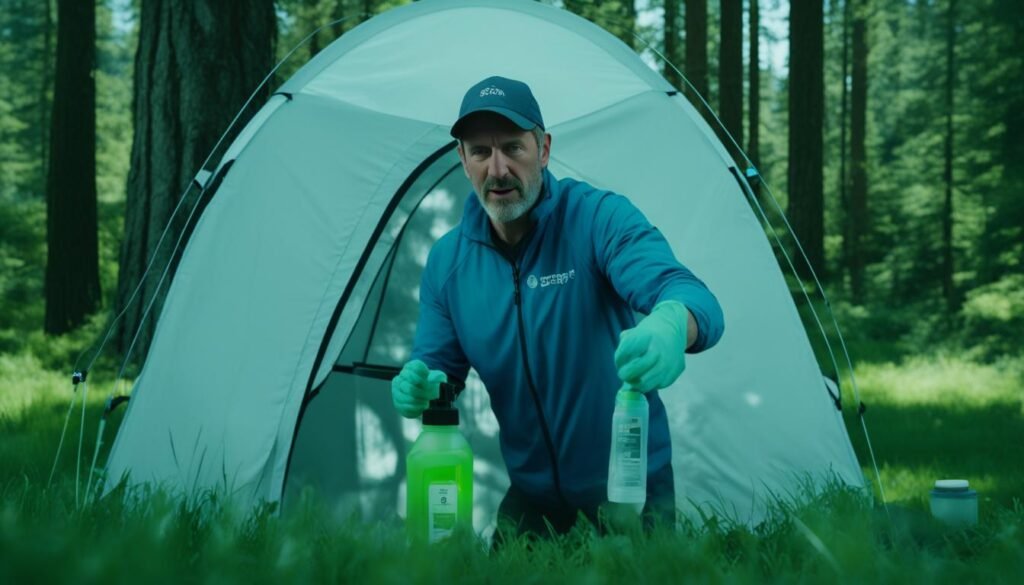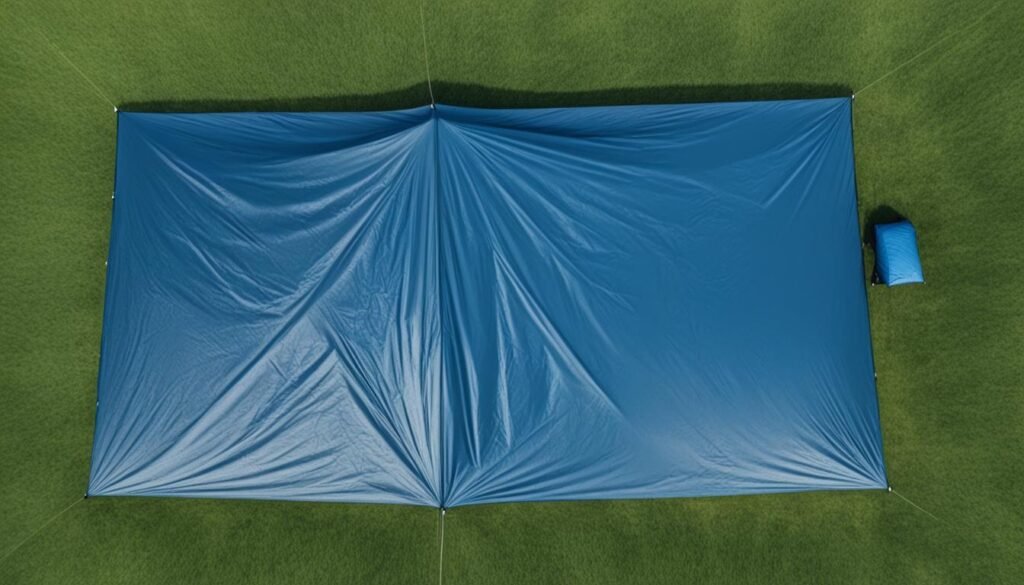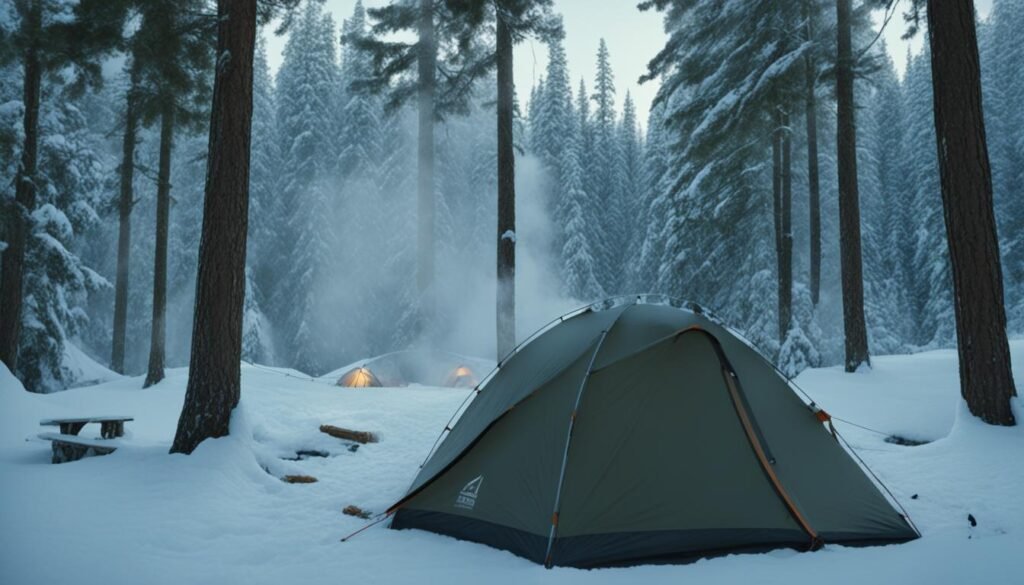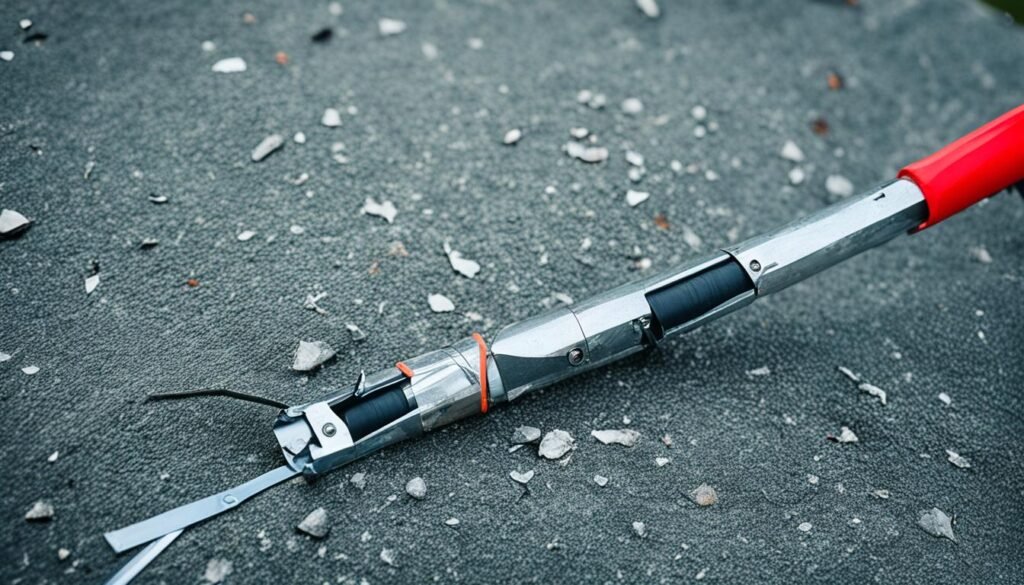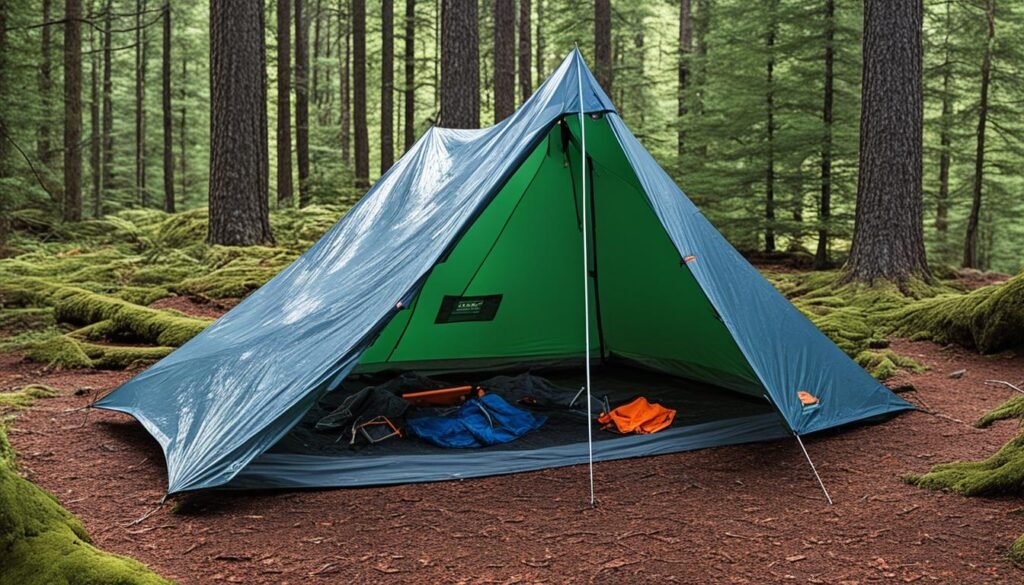Cleaning your tent is essential for maintaining its longevity and functionality. A clean camping tent not only looks better but also helps keep you comfortable during your outdoor adventures. While there are many tent cleaning products available on the market, using vinegar as a natural and eco-friendly cleaning solution can be a game-changer. In this article, I will guide you through the process of cleaning your tent using vinegar, providing you with valuable tips and insights along the way.
Key Takeaways:
- Using vinegar as a natural and eco-friendly cleaning agent is effective and safe for the environment.
- Cleaning your tent regularly helps maintain its longevity and functionality.
- Consider the type of fabric your tent is made of before using vinegar as a cleaning solution.
- Avoid common mistakes such as using aggressive cleaning products or dish soap when cleaning tent fabrics.
- Remove different types of stains from tent fabric effectively by following the proper cleaning methods.
Types of Tent Fabrics and Cleaning Considerations
When cleaning your tent with vinegar, it’s important to consider the type of fabric you’re working with. Different fabrics have distinct cleaning requirements to ensure proper care and maintenance. Let’s explore the two primary categories of tent fabrics and the cleaning considerations for each.
Coated Tent Fabrics
Example tent fabrics: All Season Residential, All Season Touring
Coated tent fabrics feature a microporous acrylic coating, which provides water-repellent properties and easy cleaning maintenance. To clean coated tent fabrics:
- Start by gently brushing away any loose dirt or debris.
- Next, dampen a soft brush with lukewarm water.
- Gently scrub the fabric in a circular motion, paying extra attention to areas with stains or soiling.
- Rinse the fabric thoroughly with lukewarm water.
Uncoated Tent Fabrics
Example tent fabrics: Cotton, PolyCotton, Campshield, Ecoline
Uncoated tent fabrics, such as cotton-based materials, require a different approach for cleaning. Here’s how to clean uncoated tent fabrics:
- Act quickly to remove any dirt or stains as soon as possible.
- Gently blot the affected area with a clean cloth or sponge to absorb excess liquid.
- Dampen a soft cloth or sponge with lukewarm water.
- Lightly scrub the fabric in a gentle, circular motion.
- If stains persist, consider using a specialized cleaner formulated for cotton fabrics.
Understanding the fabric type of your tent is crucial for effective cleaning. By following the appropriate cleaning methods for coated and uncoated fabrics, you can maintain the cleanliness and longevity of your tent.
Common Mistakes to Avoid When Cleaning Tent Fabrics
When it comes to cleaning tent fabrics, it’s important to avoid common mistakes that can cause damage. Using aggressive cleaning products like bleach, alcohol, or turpentine may seem effective but can actually harm the fabric and its coating. Dish soap and all-purpose cleaners are also to be avoided as they can break down the fabric’s water-repellent coating.
Instead, opt for a gentler approach.
Avoiding aggressive cleaning products
Aggressive cleaning products like bleach, alcohol, or turpentine can damage the tent fabric and its coating, compromising its durability and water-resistance.
Using vinegar or green soap is another common mistake to steer clear of. Although vinegar is often considered a natural cleaning agent, it can actually damage the impregnating agent in the fabric and leave a greasy film. Green soap, on the other hand, may not be suitable for all tent fabrics and can have similar effects.
Avoid these cleaning agents to maintain the integrity of your tent fabric.
Instead, focus on using mild, eco-friendly cleaning solutions specifically designed for tent fabrics. Look for products that are gentle on the fabric while effectively removing dirt and grime.
Proper Cleaning Techniques for Tent Fabrics
Cleaning your tent fabric requires a delicate touch. Here are some tips to help you clean your tent effectively without causing any damage:
- Gently remove loose dirt and debris from the surface of the fabric using a soft brush or cloth.
- If needed, spot-clean any stains using a mild detergent recommended for tent fabrics.
- Rinse the fabric thoroughly with clean water to remove any soap residue.
- Air dry the tent completely before packing it away to prevent the growth of mold and mildew.
Remember, prevention is key when it comes to maintaining the cleanliness and longevity of your tent. Regularly brushing off dirt and debris, avoiding eating or drinking inside the tent, and properly storing and drying the tent after each use can go a long way in preserving its quality.
| Mistake | Consequence |
|---|---|
| Using aggressive cleaning products | Can damage the fabric and its coating |
| Using vinegar or green soap | Can damage the impregnating agent and leave a greasy film |
Removing Different Types of Stains from Tent Fabric
When it comes to tent fabric, stains can be a common occurrence. Whether it’s bird droppings, grease stains, mold and algae, resin and candle wax, or drink stains, it’s important to know how to effectively remove them without damaging the fabric.
Bird Droppings:
When dealing with bird droppings on your tent, it’s crucial to remove the worst dirt first before proceeding with cleaning. Use lukewarm water and a cloth or soft brush to gently remove the remaining stains. This will help minimize any potential damage to the fabric.
Grease Stains:
Grease stains on tent fabric can be challenging to tackle. Start by dabbing the stain with kitchen paper to absorb excess grease. Then, use special cleaning products specifically designed for tent fabric to clean the stain. Follow the product instructions carefully to ensure effective stain removal.
Mold and Algae:
Mold and algae can be unsightly and potentially harmful if left untreated on tent fabric. To tackle mold and algae, begin by brushing the affected area with warm water. Alternatively, you can use a tent fabric cleaner for more stubborn stains. Follow the product instructions and ensure proper ventilation during the cleaning process.
Resin and Candle Wax:
Resin and candle wax stains require a specific approach for removal. Allow the resin or wax to harden completely before gently scraping off the excess. Afterward, rinse the affected area with water to remove any residue. Be cautious not to damage the fabric while removing the hardened substance.
Drink Stains:
Drink stains are a common occurrence on tent fabric, especially during camping trips. Fortunately, removing them is relatively simple. Use lukewarm water and a cloth to gently blot the stain. Avoid rubbing, as it may spread the stain further. Repeat the process until the stain is no longer visible.
Remember, it’s essential to handle stains on tent fabric with care. Avoid using harsh cleaning agents or vigorous scrubbing, as they can damage the fabric. Always follow the manufacturer’s instructions and test any cleaning products on a small, inconspicuous area before applying them to the entire stain.
| Stain Type | Removal Method |
|---|---|
| Bird Droppings | Remove excess dirt, then use lukewarm water and a cloth or soft brush for gentle cleaning. |
| Grease Stains | Dab the stain with kitchen paper, then use special cleaning products for tent fabric. |
| Mold and Algae | Brush with warm water or use a tent fabric cleaner for more stubborn stains. |
| Resin and Candle Wax | Allow to harden, then gently scrape off and rinse with water. |
| Drink Stains | Blot with lukewarm water and a cloth, avoiding rubbing. |
By following the appropriate stain removal methods, you can effectively maintain the cleanliness and appearance of your tent fabric, ensuring that it remains in optimal condition for your future outdoor adventures.
Using Vinegar as a Weed Killer
When it comes to weed control, many people prefer natural and eco-friendly alternatives to harsh chemical herbicides. Vinegar is a popular choice for those seeking a natural weed killer. While vinegar is an effective option, it’s important to understand its limitations and proper usage to achieve desired results.
The Power of Vinegar as a Weed Killer
Vinegar, particularly white vinegar with 5% acetic acid, can be used as a non-toxic herbicide to kill unwanted plants. The acetic acid in vinegar acts by drying out the foliage and stems of weeds, causing them to wither and die. However, it’s essential to note that vinegar is not selective and can harm any plant it comes into contact with, including desirable ones. Therefore, it’s crucial to use vinegar weed killer selectively and in areas where non-desirable plants or weeds are the target.
Best Uses for Vinegar Weed Killer
Vinegar weed killer is most effective when used in specific areas such as cracks between pavement, edges of driveways, or overgrown areas where non-desirable plants have taken over. By applying vinegar directly to the foliage and stems of the weeds, you can effectively kill them and inhibit their regrowth. It’s important to apply the vinegar mixture carefully to avoid contact with plants you wish to keep.
Making Your Own Vinegar Weed Killer
Creating your own vinegar weed killer is a cost-effective and environmentally-friendly option. To make a homemade vinegar weed killer, you’ll need the following ingredients:
| Ingredients | Measurements |
|---|---|
| Salt | 1 cup |
| Dish soap | 1 tablespoon |
| 20-25% acetic acid white vinegar | 1 gallon |
Note: It’s important to use gloves and protective eye gear when working with vinegar as it can be irritating to the skin.
Applying Vinegar Weed Killer Effectively
- Choose a sunny day with no rain in the forecast to apply the vinegar weed killer.
- Fill a sprayer with the vinegar mixture. Adjust the nozzle to a fine mist for precise application.
- Avoid spraying vinegar directly onto desirable plants. Hold the sprayer close to the weeds and spray the foliage and stems until thoroughly wet.
- Allow the vinegar weed killer to dry on the plants. Avoid watering or rinsing the treated area for at least 24 hours.
- Monitor the treated area for weed regrowth. Stubborn weeds may require multiple applications to completely eliminate.
By following these steps and using vinegar weed killer correctly, you can effectively control weeds in a natural and eco-friendly way. Remember to exercise caution and avoid contact with desirable plants to prevent unintended damage.
Other Outdoor Uses for Vinegar
In addition to its effectiveness in cleaning tents, vinegar has a wide range of outdoor uses that make it a versatile and valuable tool. Here are some of the other ways you can utilize vinegar in your outdoor activities:
Cleaning Clay Flower Pots
Clay pots are susceptible to stains and residue buildup over time, which can negatively affect the health of your plants. But with vinegar, you can easily remove these stains and keep your pots looking fresh. Simply mix equal parts vinegar and water, scrub the pots with this solution using a brush, and rinse thoroughly before reusing them.
Pest Control
If you’re dealing with unwanted pests like ants and cockroaches in your garden or outdoor areas, vinegar can come to the rescue. Its strong scent acts as a natural deterrent, keeping these pests away. Spray a solution of vinegar and water around problem areas or directly on ant trails to discourage their presence.
Camping Uses for Vinegar
Vinegar is an essential item to have in your camping gear. It can be used to clean your canvas tent and coolers, removing grime and odors. Diluted vinegar can also help remove rust from garden tools, keeping them in optimal condition during your camping trips.
Soil Treatment
For gardeners looking to adjust the pH level or increase the acidity of their soil for acid-loving plants like azaleas and blueberries, vinegar can be a cost-effective solution. Diluted vinegar can be applied to the soil to lower its pH level, making it more suitable for these plants.
Outdoor Furniture Cleaning
Vinegar’s cleaning properties make it an excellent choice for maintaining the cleanliness of your outdoor furniture. You can use a vinegar and water solution to wipe down surfaces, removing dirt, grime, and even mildew. Be sure to rinse the furniture thoroughly after cleaning.
BBQ Grill Cleaner
Cleaning your BBQ grill after use is essential for preventing buildup and maintaining its performance. Vinegar can be an effective and natural grill cleaner. Fill a spray bottle with vinegar, spray it onto the grates, and let it sit for a few minutes. Scrub the grates with a brush, and then rinse thoroughly with water.
Propane Lantern Wicks
If your propane lantern’s wicks have become clogged or dirty, vinegar can be used to restore their functionality. Soak the wick in a bowl of vinegar for several hours, then rinse thoroughly and allow it to dry. This process can help remove residue and improve the lantern’s performance.
Vinegar’s versatility extends beyond tent cleaning, making it a valuable companion for various outdoor tasks. From clay pot cleaning to rust removal, soil treatment to pest control, vinegar proves to be a natural, affordable, and eco-friendly solution.
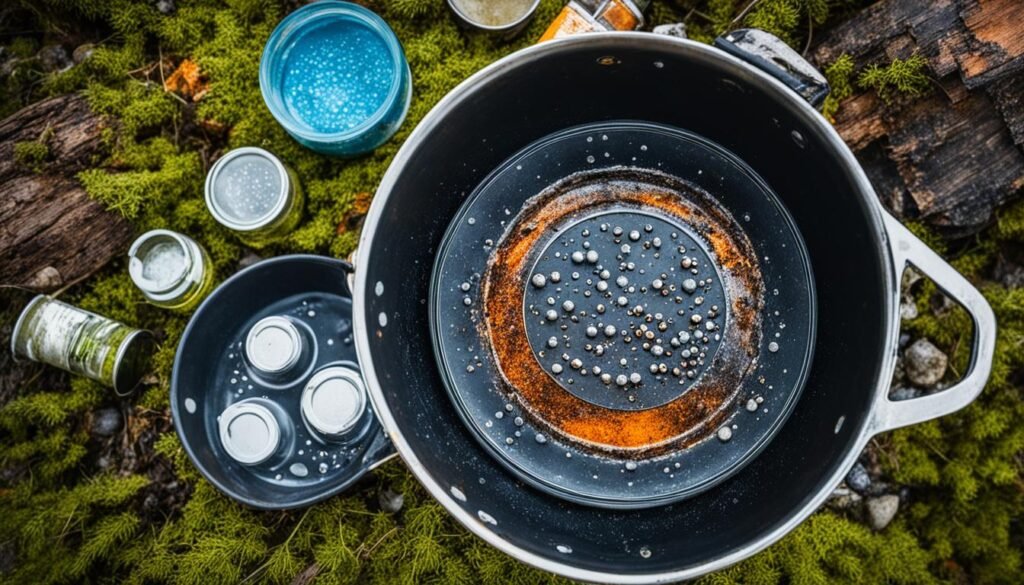
The Importance of Proper Canvas Tent Maintenance
Mold growth is a common issue with canvas tents, especially if they are not properly maintained. As an outdoor enthusiast, I understand the importance of taking care of your canvas tent to ensure its longevity. Here are some key maintenance practices that will help you prevent and treat mold on your canvas tent.
- Storing the tent completely dry: Before packing away your tent, make sure it is completely dry. Any moisture trapped in the fabric can lead to mold growth. Set up your tent at home or in a well-ventilated area and allow it to air dry thoroughly before storing it.
- Avoiding contact with moisture: While camping, try to pitch your tent in areas with good ventilation and avoid placing it directly on wet ground or near bodies of water. Moisture can seep into the fabric and create an environment conducive to mold growth.
- Treating the canvas with anti-fungal treatments: Apply anti-fungal treatments specifically formulated for canvas tents. These treatments help create a protective barrier against mold and mildew, reducing the chances of growth.
- Choosing real canvas tents: To ensure the best protection against mold, invest in a tent made of real canvas, not a cheap knock-off material. Real canvas is naturally breathable, allowing air circulation and minimizing the risk of mold formation.
- Using mold-resistant treatments: Consider using mold-resistant treatments that are specifically designed for canvas tents. These treatments further enhance the tent’s resistance to mold, although they may not cover all types of mold. Keep in mind that regular inspections and cleaning are still important.
Expert Tip:
“Regularly inspect your canvas tent for any signs of mold or mildew. If you spot any, take immediate action to prevent it from spreading. Treating mold in its early stages is much easier and more effective.”
By following these maintenance practices and taking proactive measures, you can significantly reduce the risk of mold growth on your canvas tent. Remember that prevention is key, but in case you do encounter mold, it’s crucial to address it promptly and effectively.
Continue reading to learn some expert tips for avoiding and treating mold on canvas tents.
Pro Tips for Avoiding and Treating Mold on Canvas Tents
To ensure your canvas tent remains mold-free, it’s essential to follow these expert tips and best practices. By investing in a high-quality tent made of real canvas and taking preventive measures, you can avoid mold growth and maintain the longevity of your tent.
Invest in a High-Quality Canvas Tent
When purchasing a canvas tent, prioritize quality. Look for tents made of real canvas, which is a breathable and durable material. Canvas tents are less susceptible to mold compared to synthetic materials. Additionally, choose a tent that has been treated for mold resistance to further minimize the risk.
Store the Tent Completely Dry
Proper storage is crucial for preventing mold on canvas tents. Before packing it away, ensure that your tent is completely dry. Any moisture left on the tent can create an environment conducive to mold growth. If your tent gets wet during use, make sure to dry it thoroughly before storing.
Follow Recommended Cleaning Steps
If you discover mold on your canvas tent, it’s important to take immediate action. Follow these recommended cleaning steps to effectively treat the mold:
- Set up the tent outdoors in a well-ventilated area.
- Use a soft brush or cloth to remove any loose mold spores.
- Mix a solution of mild soap and warm water.
- Gently scrub the affected areas with the soapy water solution.
- Rinse thoroughly with clean water and allow the tent to air dry.
Avoid using caustic substances like vinegar and bleach, as they can damage the canvas fabric and its water-repellent properties.
Consider Professional Tent Maintenance Services
If you are dealing with a stubborn mold infestation or are unsure about the proper cleaning methods, it may be beneficial to seek professional tent maintenance services. These experts have the knowledge and experience to effectively remove mold from canvas tents without causing damage.
| Pros of Professional Tent Maintenance Services | Cons of Professional Tent Maintenance Services |
|---|---|
|
|
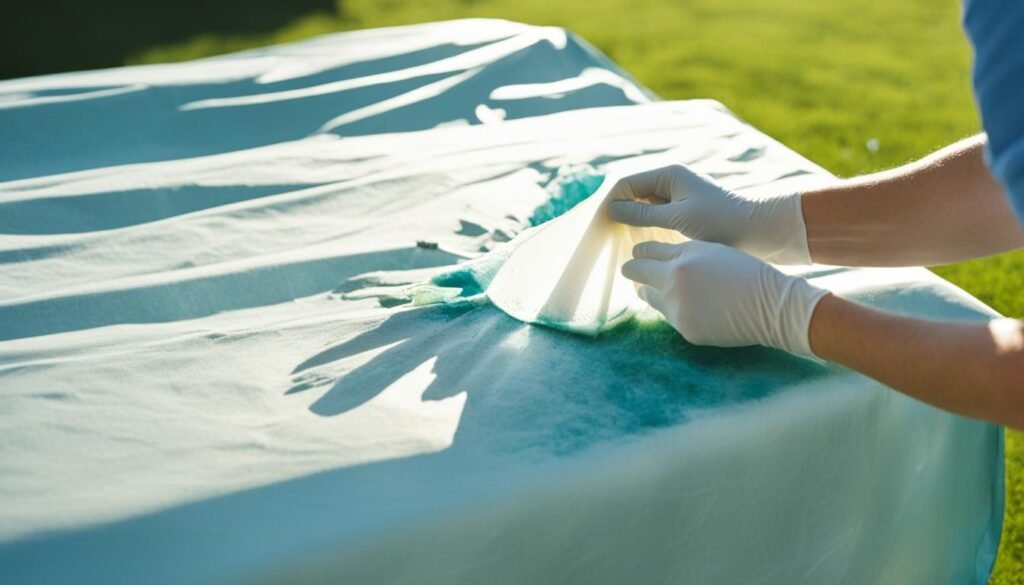
By following these pro tips, you can effectively avoid and treat mold on canvas tents, ensuring a clean and mold-free camping experience. Taking proper care of your canvas tent not only extends its lifespan but also enhances your overall camping enjoyment.
Conclusion
Cleaning your tent with vinegar is not only an effective way to maintain its cleanliness and longevity but also a eco-friendly solution. By following proper cleaning methods and avoiding common mistakes, you can easily remove stains and prevent mold growth on your tent fabric. Whether you have coated or uncoated fabrics, choosing the right type of tent cleaner is crucial to ensure optimal performance.
Remember, vinegar can be used for more than just tent maintenance. It is a versatile tool that can help with various outdoor cleaning and pest control tasks. From removing stains on clay pots to cleaning BBQ grills, vinegar is a valuable and natural solution for eco-conscious campers.
For canvas tent owners, proper maintenance is key to preventing mold growth. Make sure to store your canvas tent completely dry and consider treating the canvas with anti-fungal solutions. If you do encounter mold, follow the recommended cleaning steps and avoid using caustic substances like vinegar and bleach.
In conclusion, vinegar is a natural and eco-friendly tent cleaning solution that can effectively keep your tent in pristine condition. By incorporating vinegar into your tent maintenance routine and following best practices, you can ensure a clean and enjoyable outdoor experience.
FAQ
Can I clean my tent with vinegar?
Yes, vinegar can be used as a natural and eco-friendly cleaning agent for your tent.
What type of fabric can be cleaned with vinegar?
Vinegar can be used to clean coated tent fabrics, such as All Season Residential and All Season Touring.
How should I clean uncoated tent fabrics with vinegar?
Uncoated tent fabrics like Cotton, PolyCotton, Campshield, and Ecoline should be cleaned with gentle brushing using lukewarm water.
What cleaning products should I avoid when cleaning tent fabrics?
Avoid using aggressive cleaning products like bleach, alcohol, turpentine, dish soap, and all-purpose cleaners as they can damage the tent fabric and its coating.
How can I remove bird droppings from my tent fabric?
Remove the worst dirt first, then clean with lukewarm water and a cloth or soft brush.
What is the best way to clean grease stains from tent fabric?
Dab the grease stains with kitchen paper and clean with special cleaning products for tent fabric.
How do I remove mold and algae from my tent fabric?
Brush the affected area with warm water or use a tent fabric cleaner to remove mold and algae stains.
What is the proper method to remove resin and candle wax from tent fabric?
Allow the resin and candle wax to harden, then scrape off and rinse with water.
How can I get rid of drink stains on my tent fabric?
Clean drink stains with lukewarm water and a cloth.
Can I use vinegar as a weed killer?
Yes, vinegar can be used as a natural weed killer. However, it should be used carefully as it can harm most plants and should be applied in non-desirable areas.
What are some other outdoor uses for vinegar?
Vinegar can be used for cleaning clay flower pots, pest control for ants and cockroaches, and for cleaning camping gear, garden tools, outdoor furniture, BBQ grills, and propane lantern wicks.
How can I prevent mold growth on my canvas tent?
Properly store your canvas tent completely dry, avoid moisture contact, and consider treating the canvas with anti-fungal treatments.
What should I do if I encounter mold on my canvas tent?
Follow proper cleaning steps to remove mold, avoid using caustic substances like vinegar and bleach, and consider professional tent maintenance services for difficult mold infestations.
Why is proper canvas tent maintenance important?
Proper canvas tent maintenance ensures the longevity and performance of your tent, and helps prevent mold growth and other issues.
How can I avoid and treat mold on my canvas tent?
Invest in a high-quality tent made of real canvas and treated for mold resistance. Store your tent completely dry and follow proper cleaning steps to remove mold. Consider professional tent maintenance for difficult mold infestations.
Can vinegar be used to clean tents in an eco-friendly way?
Yes, cleaning your tent with vinegar is an eco-friendly solution that effectively removes stains and prevents mold growth.

